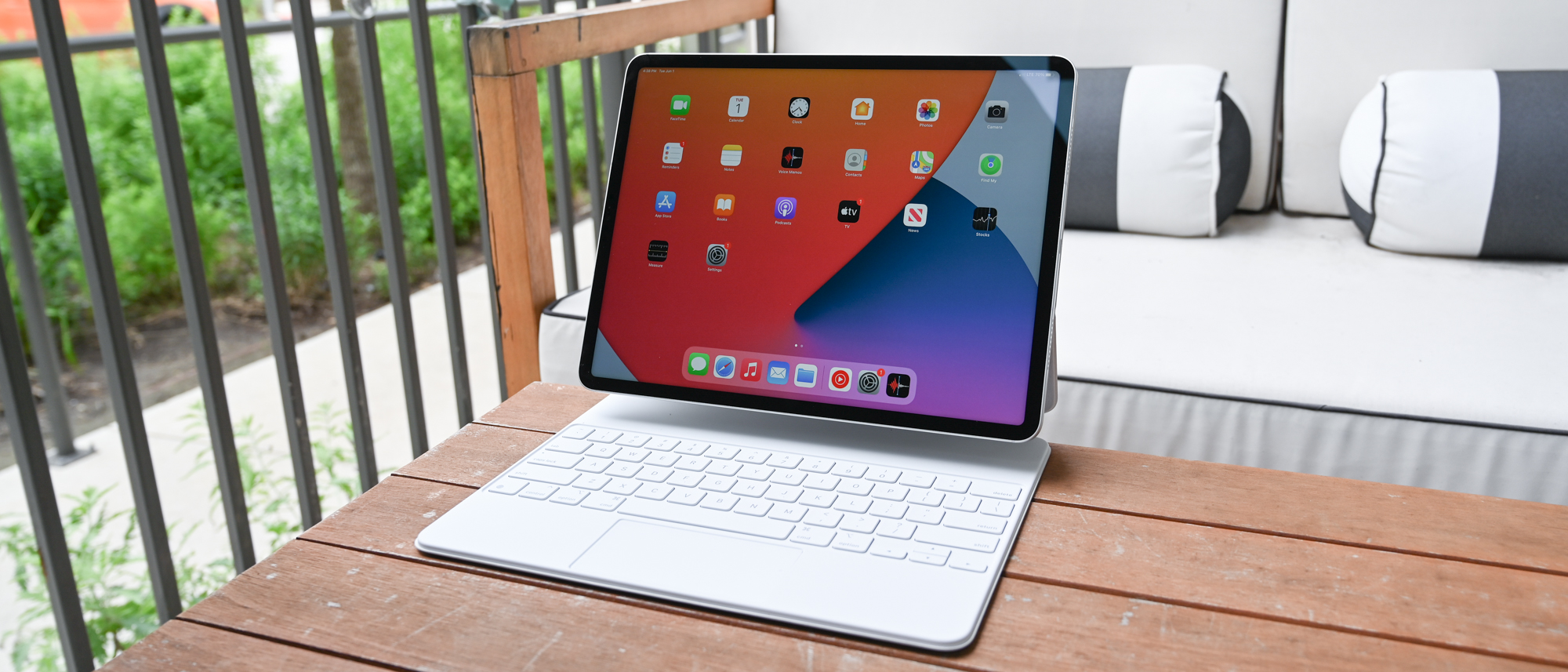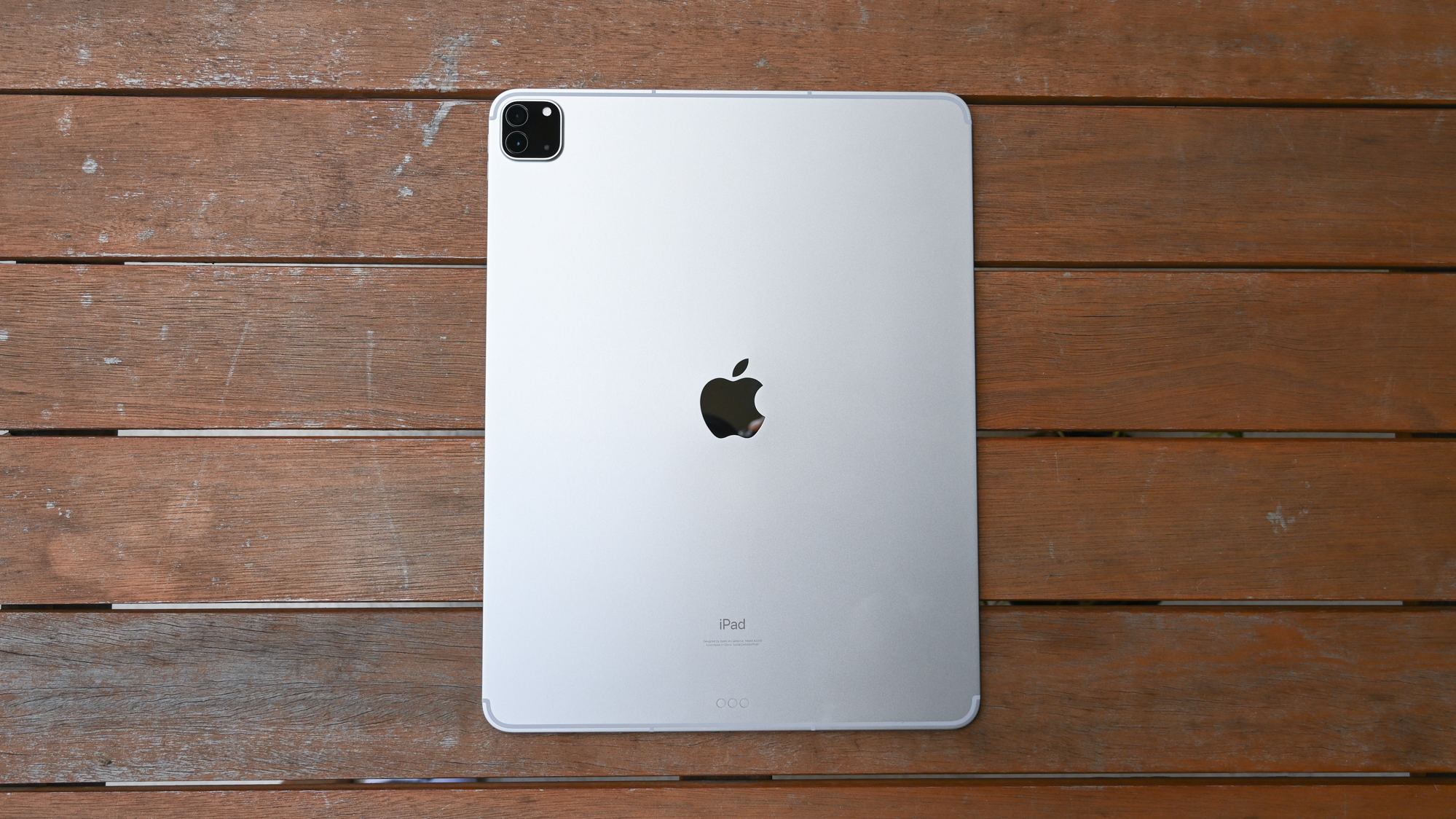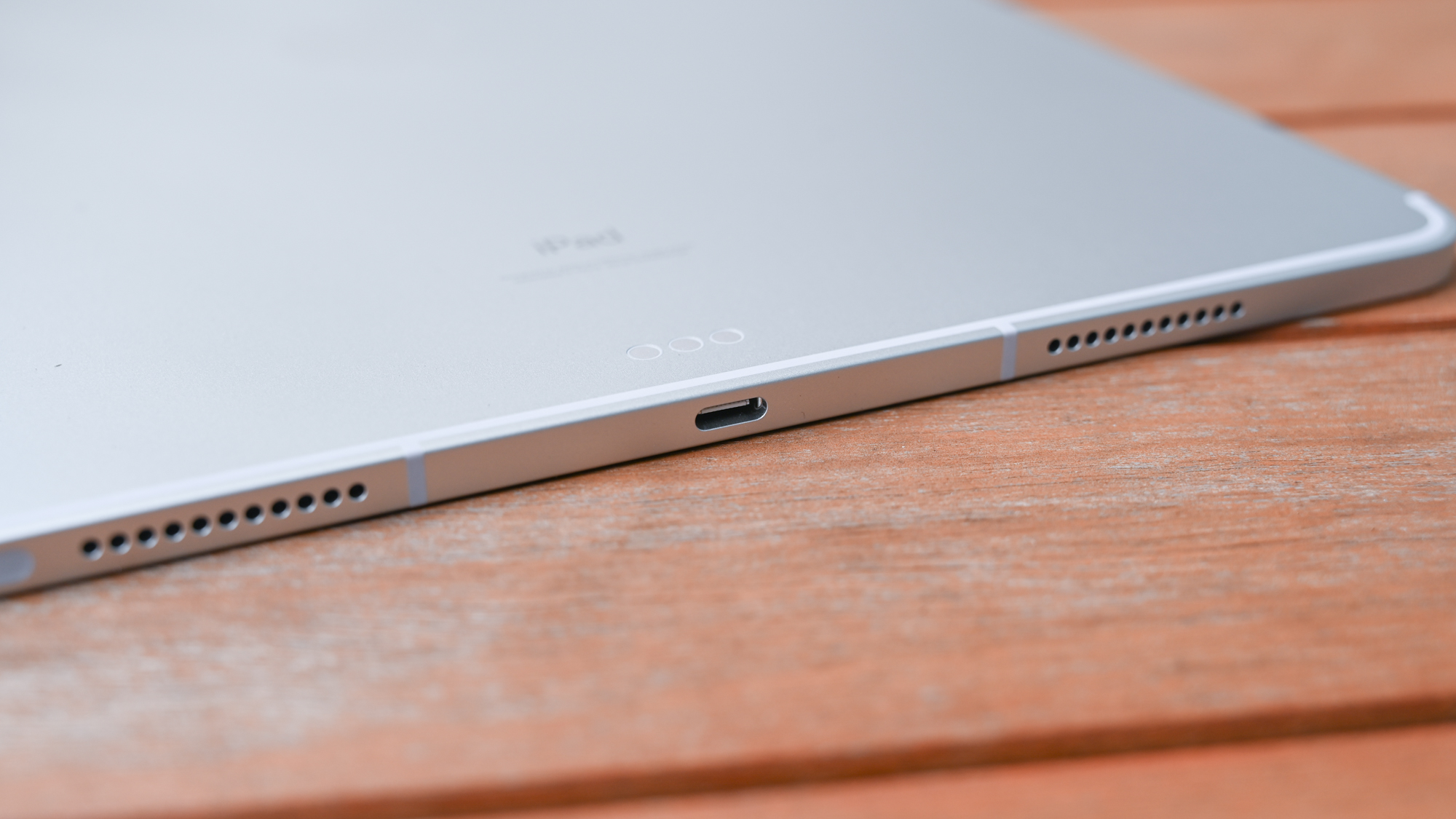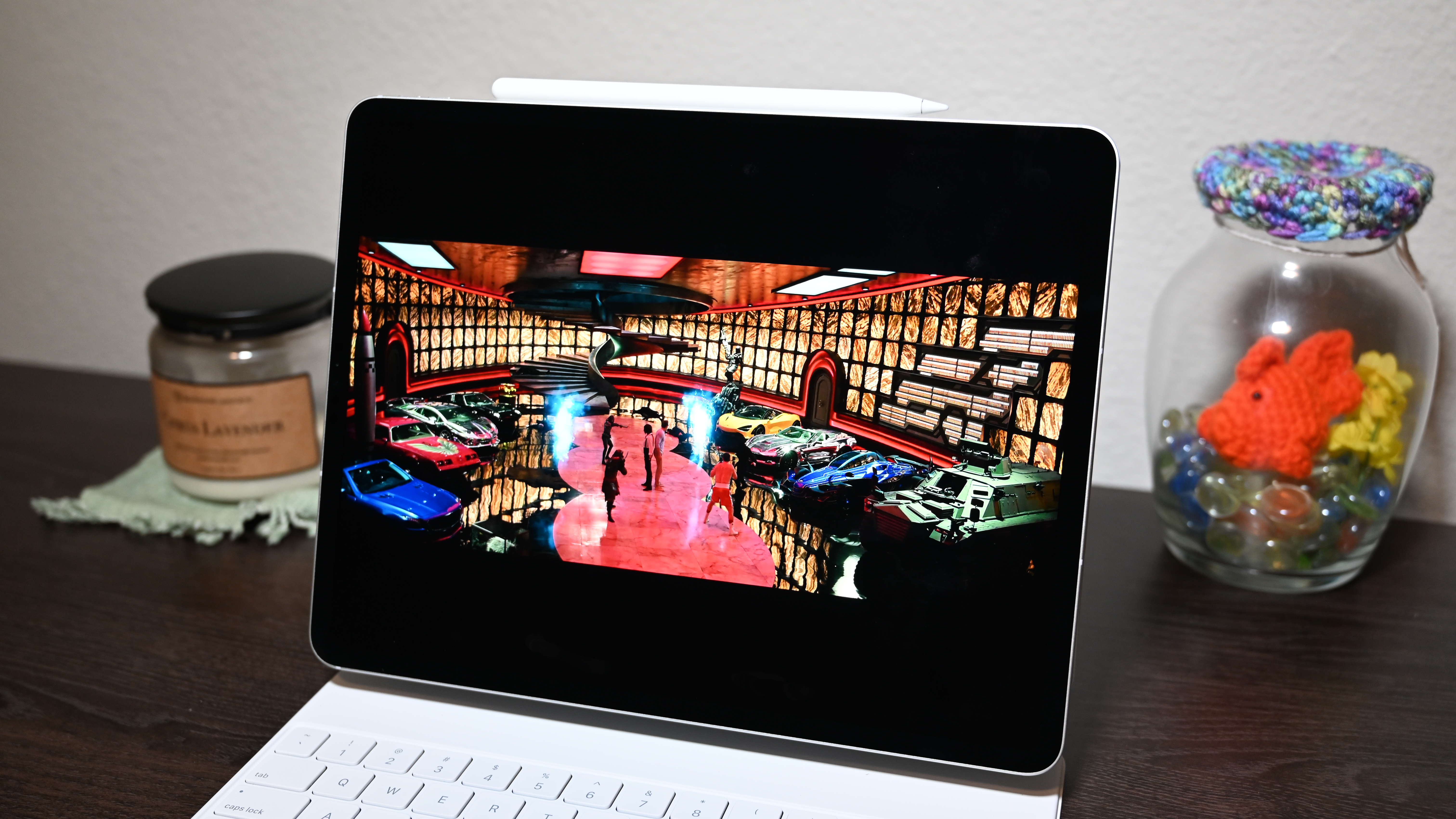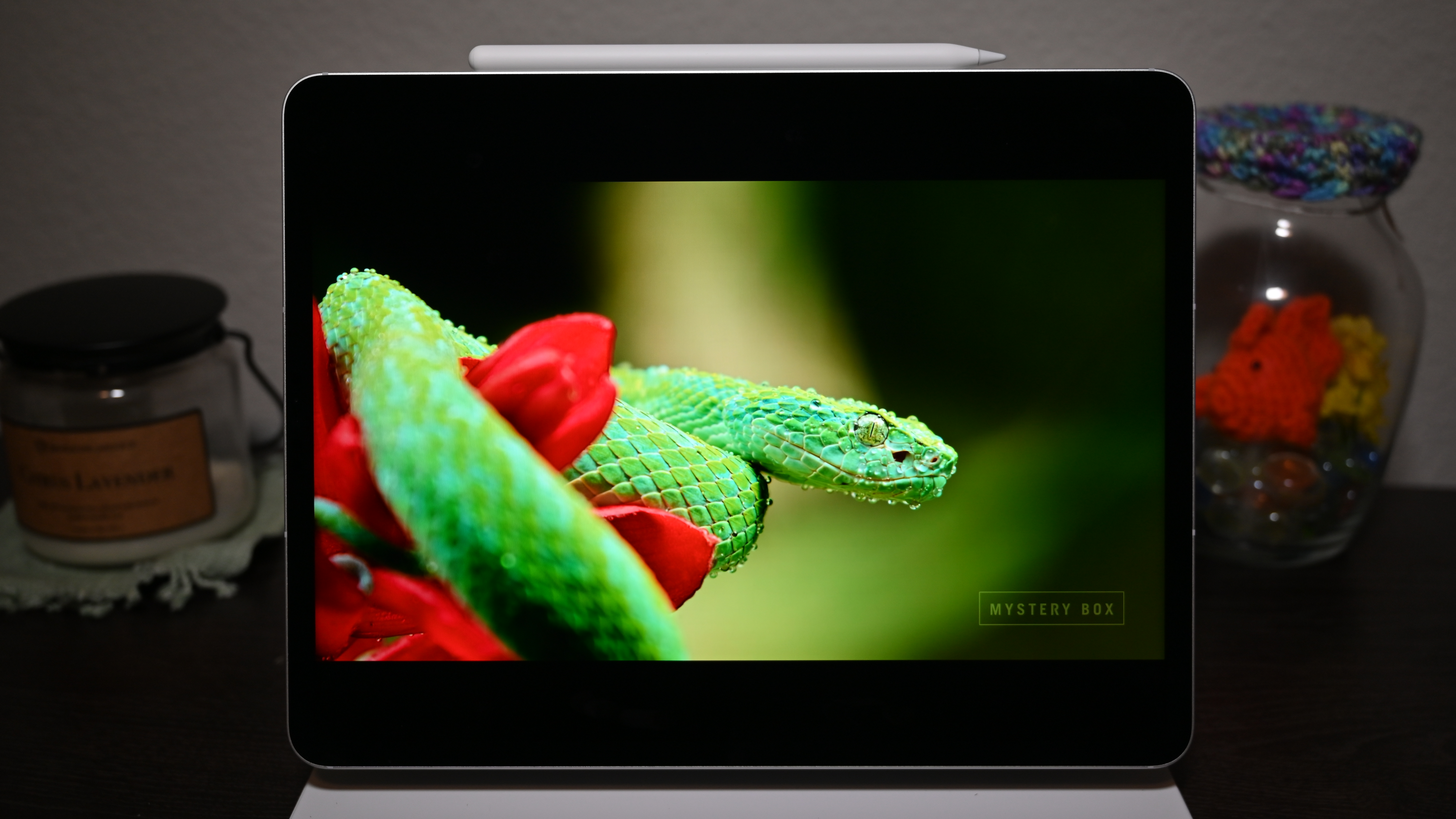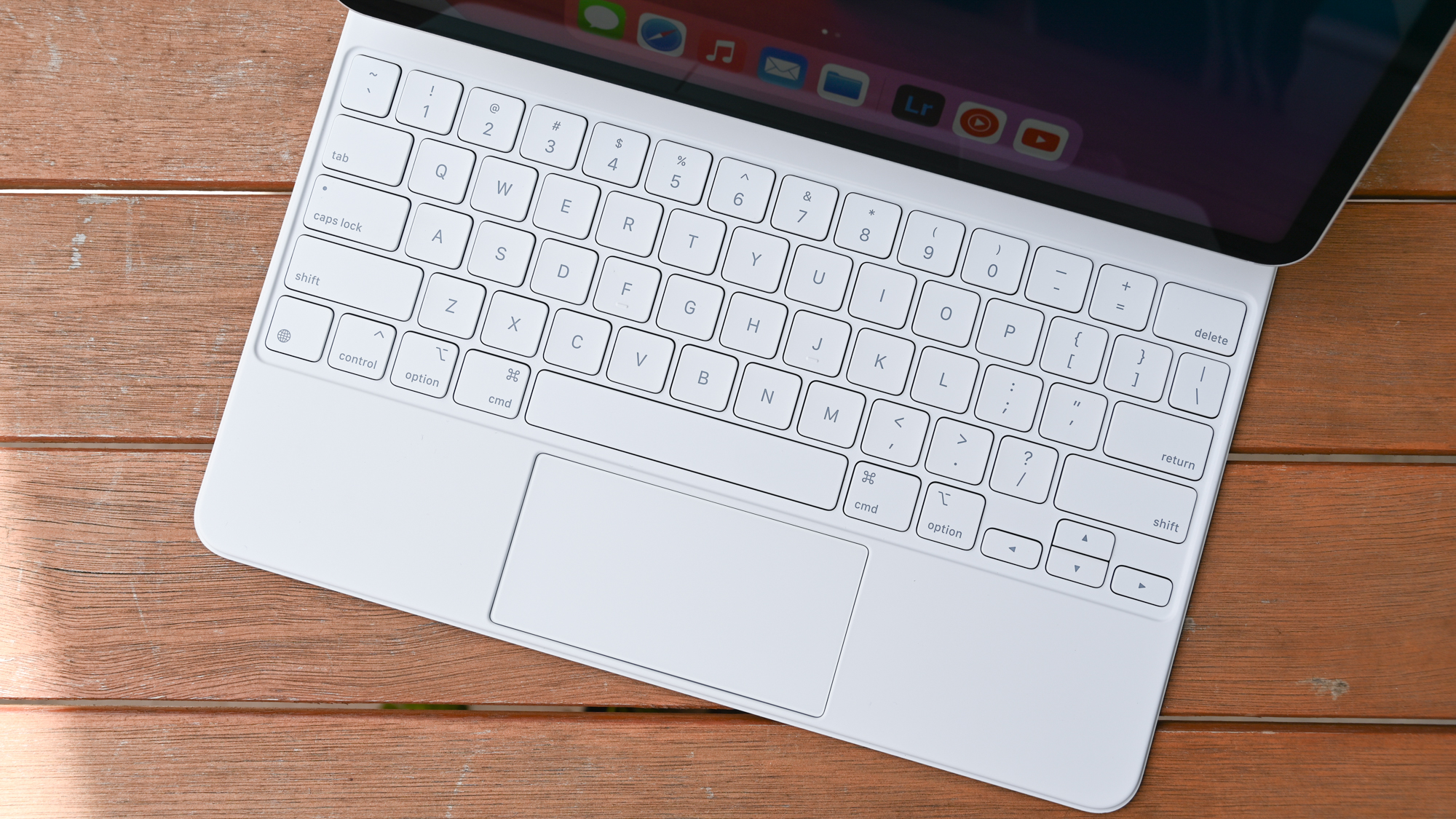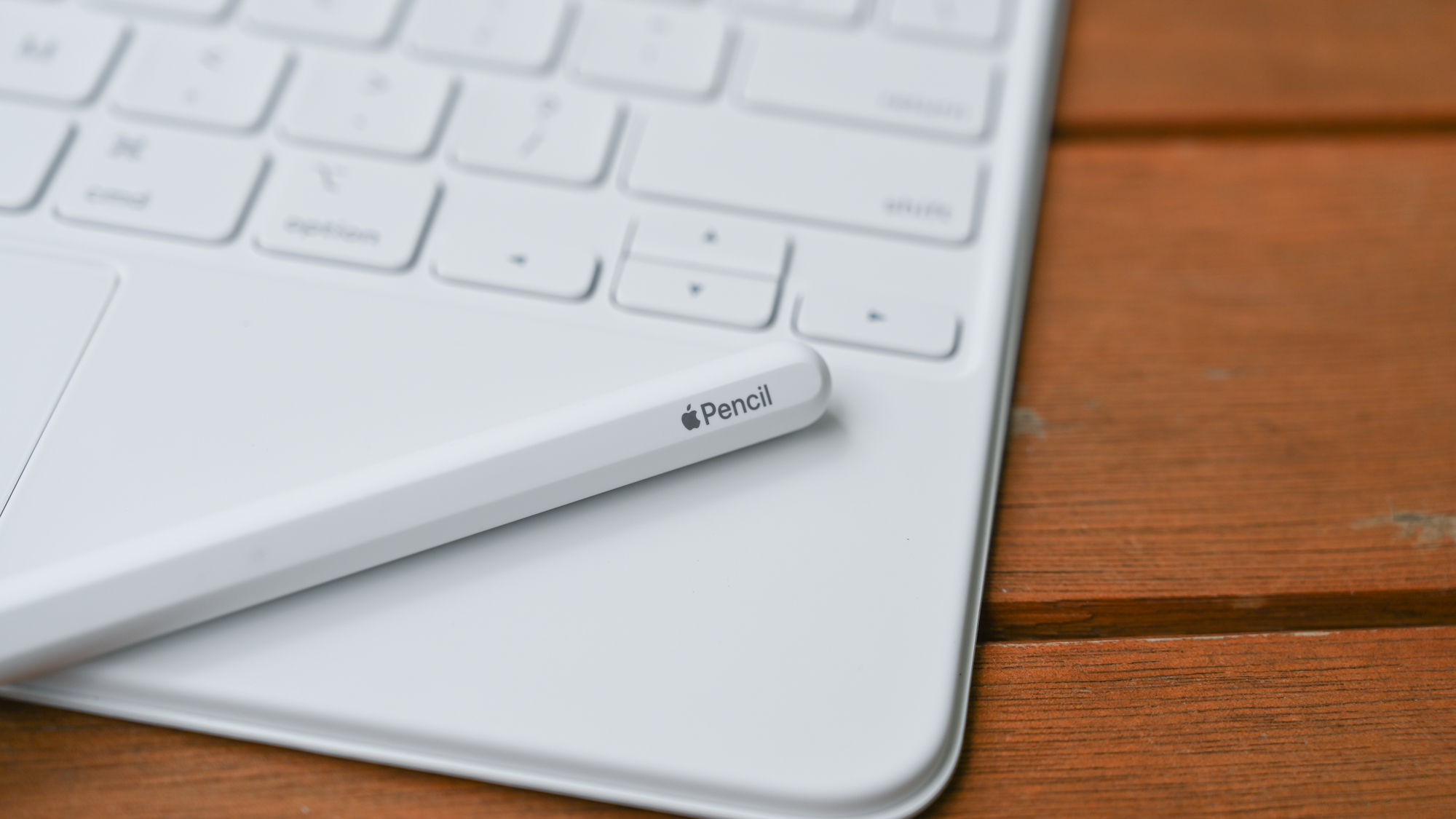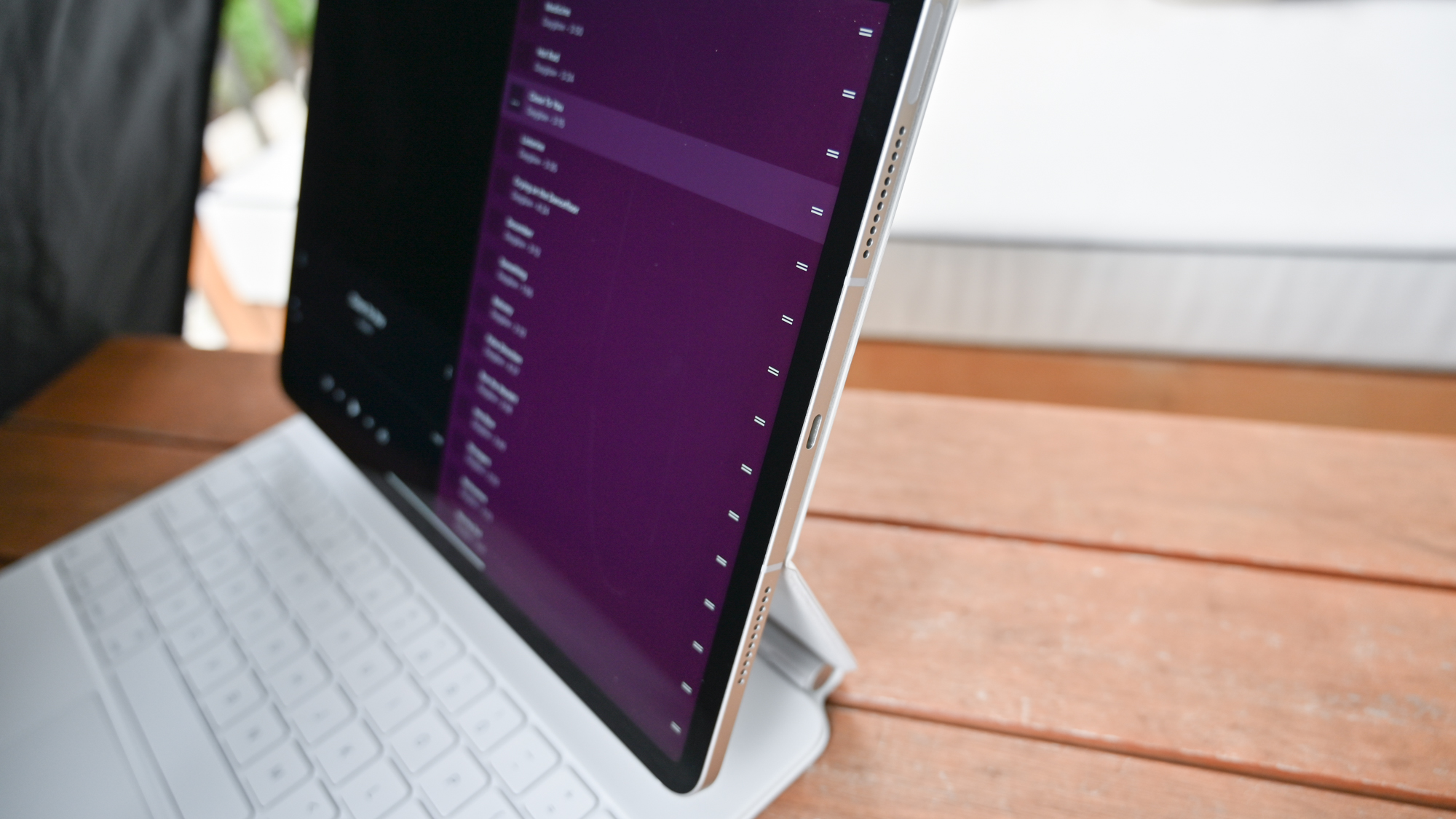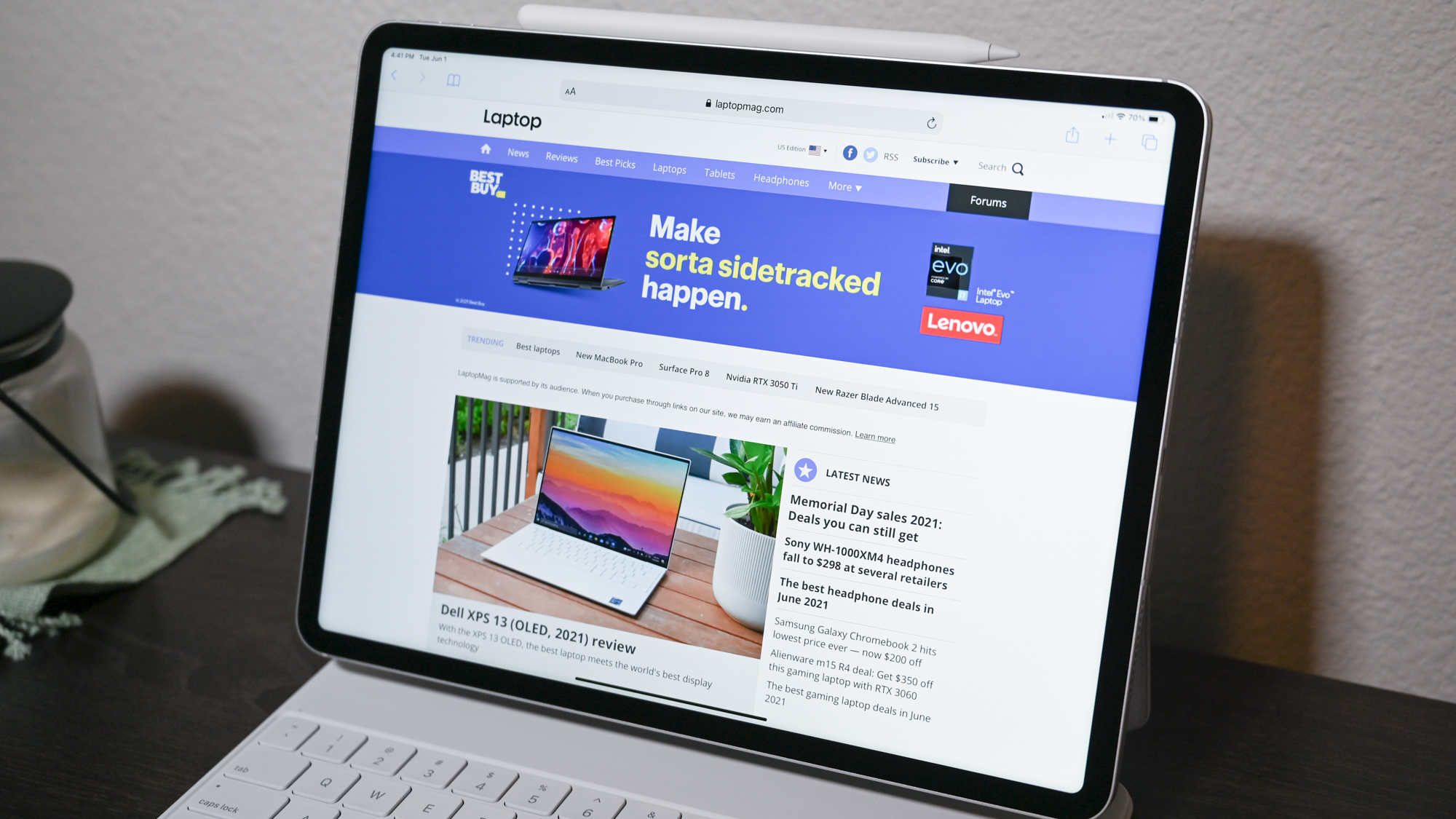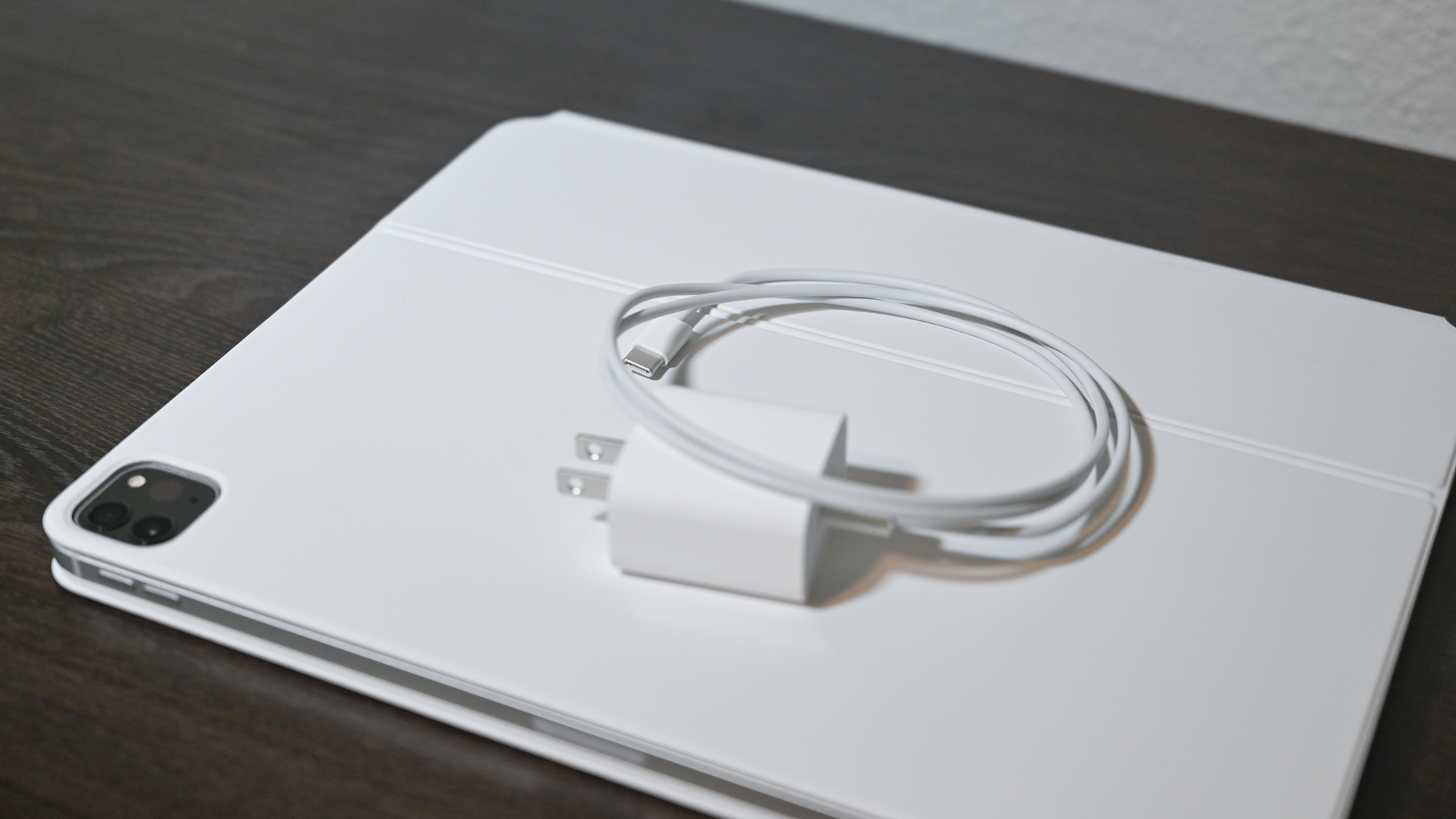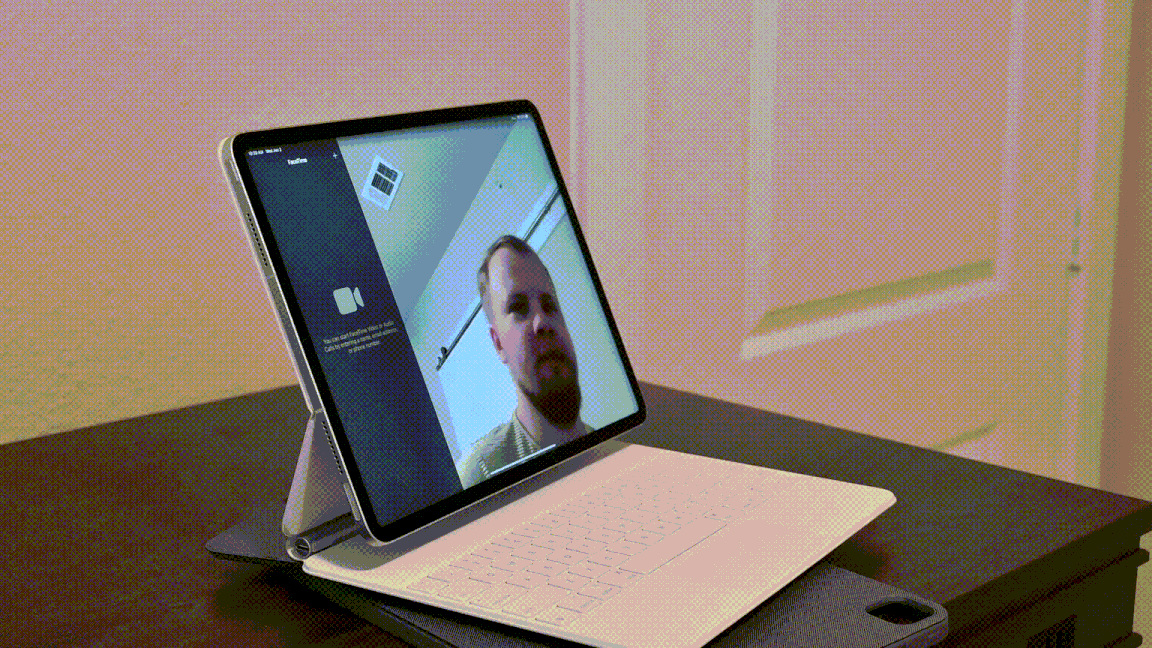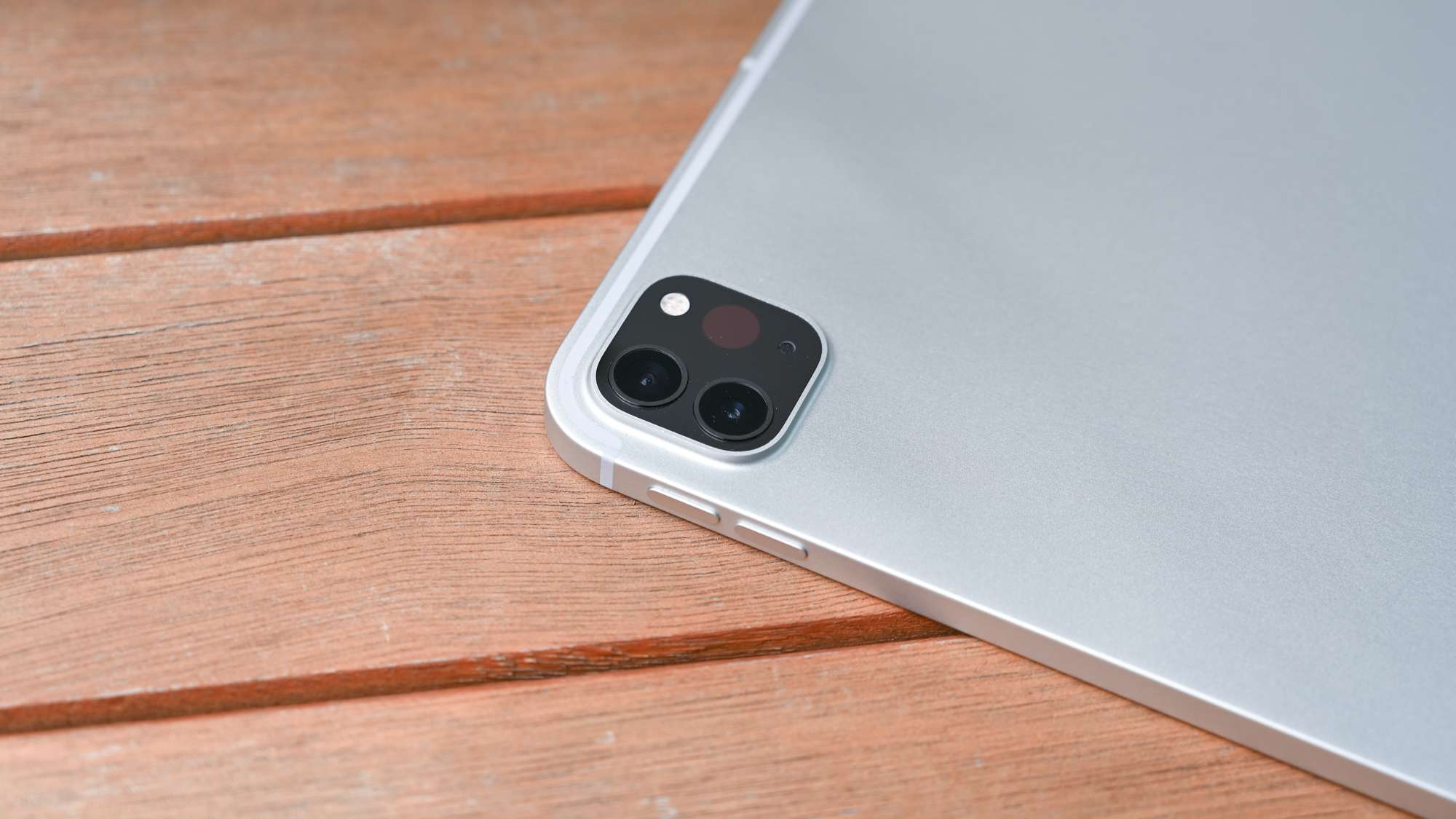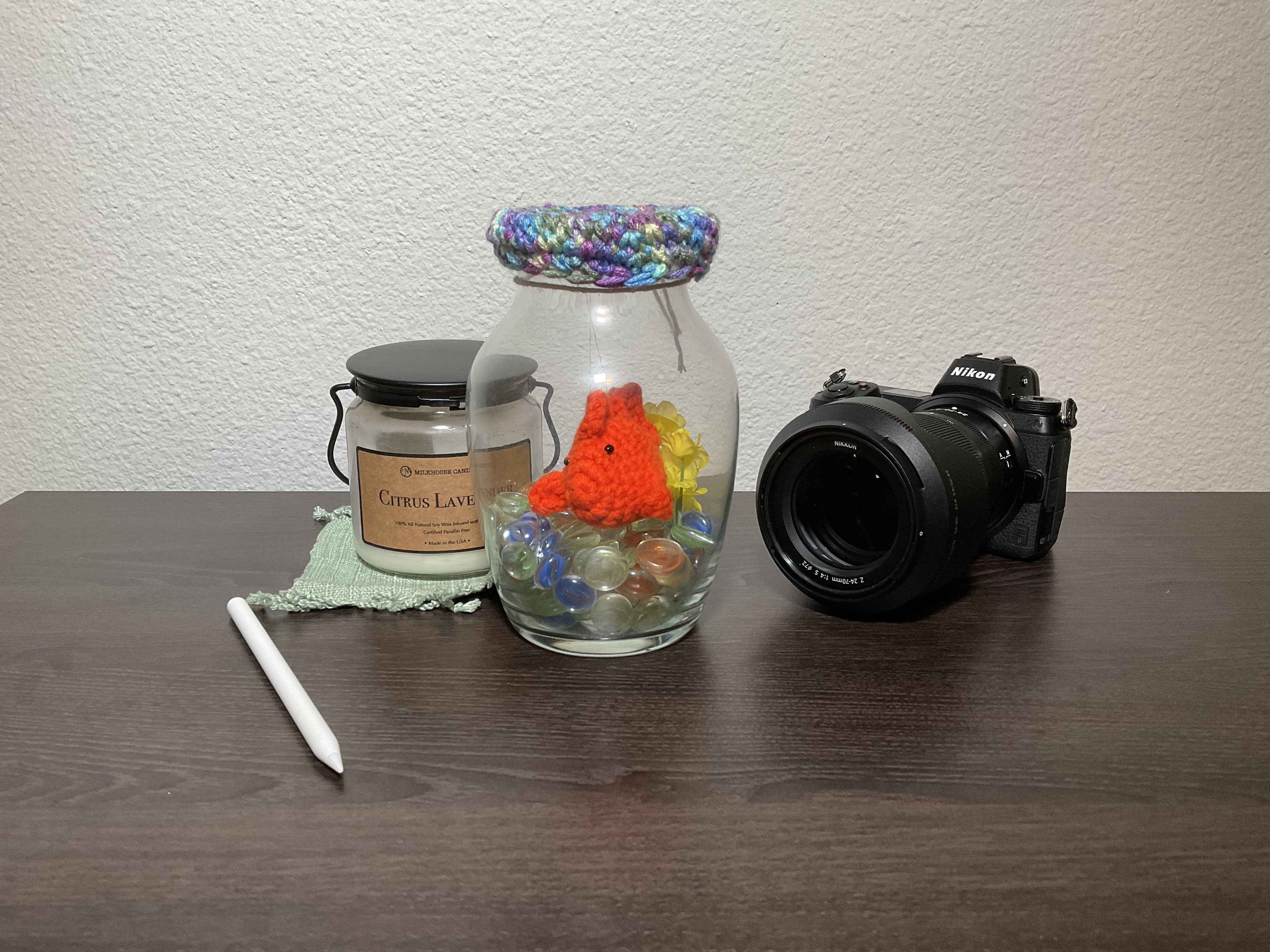Laptop Mag Verdict
Apple's iPad Pro 2021 brings display, processor and connectivity upgrades to what was already the world's best (and most expensive) tablet.
Pros
- +
XDR display can get bright and vivid
- +
M1 chip is outrageously fast
- +
Slim, durable chassis
- +
Thunderbolt 3 and USB4 support
- +
Improved front-facing camera with Center Stage
- +
5G wireless speeds
Cons
- -
Display has some limitations
- -
iPadOS can feel restricting
- -
Expensive
Why you can trust Laptop Mag
Price: $1,099 (starting)
OS: iPadOS 14.5
CPU: M1
Storage: 128GB, 256GB, 512GB, 1TB, 2TB
Display: 12.9 inches (2732 x 2048 pixels) mini-LED
Rear cameras: 12MP wide (f/1.8), 10-MP ultra-wide (f/2.4)
Video: 4K up to 60 fps
Front camera: 12MP TrueDepth
Wireless: Wi-Fi 6, 5G
Battery life (tested): 10 hours 48 minutes
Size: 11.04 x 8.46 x 0.25 inches
Weight: 1.5 pounds
When a tablet arrives with major upgrades to its processor, display and wireless connectivity, you expect it to feel like a new experience. That isn't the case with the iPad Pro 2021. At least, not initially. Out of the box, the iPad Pro acts much like its predecessor. It's lightning-fast, has a gorgeous 12.9-inch display, and is as feature-packed as ever — so where is the added spice?
Don't worry, the iPad Pro 2021 is a product you'll appreciate the more you use it. The new Liquid Retina XDR display with mini-LED technology may not blow you away initially, but playing HDR content showcases how much brighter and more vivid it can get compared to previous Retina panels. While the M1 brings huge performance gains, you probably won't notice them until you've put this tablet to the test by running intensive apps or workflows. Then there is the addition of 5G, which is still several years away from reaching its true potential.
- iPad Pro vs. iPad mini vs. iPad: Which tablet is best?
- MacBook Air vs. MacBook Pro: Which laptop should you buy?
- Best cheap tablet deals in 2021
These additions, combined with more straightforward upgrades like Thunderbolt 3 support and an improved front-facing camera, make the iPad Pro 2021 the best Apple tablet ever. They don't, however, make the iPad Pro the go-to tablet for everyone, even though it's one of the best kids tablets. Let's find out why.
iPad Pro price and configuration options
The iPad Pro 2021 (12.9-inch) starts at $1,099 for the 128GB Wi-Fi model with 8GB of RAM, making it $100 more expensive than the previous model. Doubling storage to 256GB brings the price to $1,199. From there, you can buy a 512GB model for $1,399, or pay $1,799 for 1TB and 16GB of RAM. If you can't store in the cloud, or work with gigantic files, the 2TB model with 16GB of RAM costs $2,199.
Opting for a cellular model with 5G support adds $200 to the price of the Wi-Fi configurations.
iPad Pro design
Identical to the previous model, apart from some added weight (more on that later), the iPad Pro is a stylish slate with a sophisticated aluminum design, slim display bezels and a flat-edge shape.
Apple brought fresh colors to the iPad Air, iMac and iPhone 12, but the iPad Pro is stuck with bland Space Gray and boring Silver. Perhaps suit-wearing execs want gadgets with a discrete, professional appearance. But come on, Apple, have some fun! After all, content creators, the other group the iPad Pro targets, want some pizzazz in their life.
Sign up to receive The Snapshot, a free special dispatch from Laptop Mag, in your inbox.
The rear of the iPad Pro sports a centered chrome Apple logo below a squircle camera module housing dual vertically oriented lenses and a LiDAR sensor (much like the iPhone 12). Gray antenna bands hug the top and bottom of the slate.
The edges of the iPad Pro are flat, which gives the slab a stately stature while the aluminum frame feels robust. Lining those flat edges is a power button on the top-right corner, volume up and down buttons and a SIM card slot on the right, and a USB port on the bottom. The front-facing camera is located at the top when the tablet is vertically orientated, which can be problematic (more on that later).
My two favorite hardware features are the thin bezels bordering the display; they draw your eyes toward the gorgeous 12.9-inch panel. The other is the charging pad, which magnetically holds and tops off the Apple Pencil 2.
At 11 x 8.5 x 0.25 inches and 1.5 pounds, the iPad Pro 2021 is slightly bulkier than the iPad Pro 2020 (11.04 x 8.46 x 0.23 inches, 1.41 pounds), and heavier than the Samsung Galaxy Tab S7 Plus (10 x 6.51 x 0.25 inches, 1.3 pounds). The Microsoft Surface Pro 7+ is a chunkier tablet both in size (11.5 x 7.9 x 0.3 inches) and weight (1.8 pounds).
iPad Pro ports
The iPad Pro has a single USB-C charging port on the bottom edge with Thunderbolt 3 and USB4 support.
That gets you data throughput of up to 40Gbps (up from 10Gbps) and the ability to connect to 4K and 5K monitors along with compatibility with a range of USB-C accessories.
iPad Pro display
The new Liquid Retina XDR display feels more like an evolution of LED than the revolution OLED sparked. Colors are vibrant and the screen gets very bright, but don't expect the same eye-popping tones found on the Galaxy Tab S7 Pro's AMOLED panel. Part of the reason, I suspect, is that Apple wants to keep its signature "natural" look; colors on the 12.9-inch screen are accurate without being oversaturated. But as a result, the screen on the new iPad Pro doesn't look much different than its predecessor — at least while viewing non-HDR content (most TV shows and movies on streaming services).
I don't mean to suggest that non-HDR content looks bad, quite the contrary. In a 1080p trailer for Free Guys, Ryan Reynold's sky blue shirt was so sharp, I wanted to reach out and touch it. The blood caked onto his broken nose was a rich merlot and the freshly painted cars parked in a hangar were like Skittles; every color of the rainbow.
Everything changes when you watch an HDR video in full-screen mode. The brightness jumps up to absurd levels, allowing the colors to burst off the screen. Photo quality becomes much closer to what you find on an OLED TV or laptop panel.
Now let's talk about the worm in this Apple, or what is being referred to as "blooming." This is when bright pixels bleed into nearby dark pixels causing them to glow. Before you get angry at Apple, the problem stems from the underlying mini-LED technology. Instead of a uniform backlight, mini-LED consists of 2,500 local dimming zones that can illuminate during bright scenes or turn off completely during dark ones. Apple already acknowledged the blooming effect in a support document.
I noticed the blooming only in certain settings menus and when I intentionally replicated the conditions that could cause the effect. That is, in a completely dark room while viewing a dark background with bright objects or writing. The photo I've included is as close to what I see from the naked eye as possible. Keep in mind that photos can exaggerate the blooming effect when taken at a slower shutter speed so don't believe everything you see online.
Moving on to the benchmarks, we tested the screen twice: once with HDR and once playing non-HDR content. Our colorimeter registered 563 nits of brightness when showing non-HDR content, which puts it right around the iPad Pro 2020 (559 nits), and ahead of the Surface Pro 7+ (358 nits) and the Galaxy Tab S7 Plus (430 nits).
Switching to HDR content lets the mini-LED shine, literally. The iPad Pro's XR screen hit 1,582 nits when we looked at 10% of the screen that was illuminated. We expanded our view to 40% of the panel and measured 1,588 nits. When we tested the entire screen playing HDR content, it hit a blinding 1,251 nits.
Color coverage is also somewhat limited, showing how much punchier the Galaxy Tab S7 Plus' AMOLED panel looks compared to the iPad Pro's screen. The iPad Pro 2021 produces 115% of the DCI-P3 color gamut whereas the Surface Tab S7 Plus hit 211%. Surprisingly, the iPad Pro 2021 is less vivid than the iPad Pro 2020 (123%), though it tops the iPad Air (103%).
iPad Pro keyboard
There are two official iPad Pro keyboard covers and various third-party options.
Apple sent me the Magic Keyboard, which I've previously reviewed in full. This latest version is identical to the previous one apart from two changes. First, the Magic Keyboard now comes in white. It is a crisp, white hue that matches the Apple Pencil; the smooth finish feels nice, but is very slippery. Also, the white surface shows dirt and grime more than the black variant.
I kindly suggest reading my full Magic Keyboard review. The TL;DR version is that the backlit keys feel great to type on, and the floating design is clever and uses sturdy cantilevered hinges, but there are some major drawbacks. Chief among those is the weight (1.6 pounds), that you can't use the iPad Pro as a regular tablet without detaching it from the accessory, and the dizzying price of $349.
It is, however, a major upgrade from the $199 Smart Keyboard, which has shallow keys and lacks a touchpad, meaning you can't take advantage of all the cursor-friendly features Apple has added to iPadOS in the past year.
iPad Pro Apple Pencil 2
We didn't get a new stylus this year, but the Apple Pencil 2 is one of the better ones on the market. It is also one of the most expensive at $129, but artists, students, designers or anyone who prefers hand-written notes will get their money's worth.
The length and girth of the pen make it suitable for most hand sizes, and the weight is evenly balanced so the pen doesn't see-saw as you write. The one-sided flat edge reminds me of the legendary Lamy Safari fountain pen, which contours nicely to your grip.
I can't begin to pose as an artist, but the pencil reacted quickly to my erratic swipes as I drew a very rough sketch of a flower. There was no perceivable latency and the pen supports tilt. Also, the double-tap feature on the touch-sensitive edge let me changing tools and switch to the eraser (something I did often) with ease.
I love how the pen magnetically attaches to the edge of the iPad Pro with a satisfying snap and immediately begins charging. The tablet alerts you when the stylus is properly placed though I had no issues finding the sweet spot. The pen feels sturdy on the edge, but because it uses a magnetic instead of a loop, it can get knocked off when slid into a bag or backpack.
iPad Pro audio
Four speakers are split evenly on the top and bottom edges of the iPad Pro and pack some serious sonic oomph. My wife and I had fun jamming out to LEISURE's "Take You Higher." The relaxing vocals were clear and present, and there was an airiness to the electronic instrumentals that sounded great as the soul-meets-pop band dished out funky grooves.
We couldn't help but bob our heads to Dayglow's retro bop "Close to you." The groovy electronic tones were crisp beneath the singer's smooth vocals while the softly thudding bass kept the frenetic rhythm. When the falsetto chorus sets in, the tablet did a good job of keeping the treble tones sounding crisp without them becoming peaky or sharp. Yes, the speakers lack depth and can sound digitized when too many noises enter the soundstage, but as far as tablet speakers go, these are some of the best.
iPad Pro performance
iPad Pro, meet the M1. Using the same chip found in the entry-level MacBook Pro and MacBook Air, the 2021 iPad Pro takes the fastest tablet on the market and pumps it with rocket fuel. It is fast to the point where I wouldn't know where to begin in my trials to push the iPad Pro to its computing limits. I'd be surprised if any iPad Pro owner found the performance ceiling of this slate unless you run demanding programs typically meant for laptops or desktops.
For most users, the M1 chip means everything will run slightly faster and smoother than before. Apps opened instantly, websites blinked onto the screen, and navigating the OS was a silky, delay-free joy.
I fired up Civilization VI, a notoriously intensive game. The tutorial ran great. Load screens never lingered too long and animations were buttery; within minutes, I was training warriors to protect my city and started researching mining to advance our technologies. I then downloaded Adobe Lightroom, an excellent free photo editing app, and did some minor editing. Again, the iPad Pro held its ground, allowing me to adjust lighting, contrast, and crop without skipping a beat.
On the Geekbench 5 overall performance test, the iPad Pro scored a 7,298, crushing the iPad Air (4,262, A14 Bionic), the previous iPad Pro (4,720, A12Z) as well as anything released by the competition including the Surface Pro 7+ (4,825, Core i5-1135G7) and the Samsung Galaxy Tab S7 Plus (Snapdragon 865+, 2,910).
When we ran the Adobe Premiere Rush test, the iPad Pro with its M1 chip took 22 seconds to add a color filter and transition to a 4K video before exporting it to 1080p resolution. The previous model needed 22 seconds and the iPad Air clocked in at 27 seconds.
iPad Pro 5G
New to the iPad Pro is 5G support. In the US, that means both high-speed mmWave 5G and sub-6Ghz 5G for the widest coverage across multiple carriers including Verizon, T-Mobile, and AT&T. Apple depicts the flavor of 5G you're receiving with a specific icon in the status bar. If you're in an area with the latest wireless standard, you'll either see a 5G, 5G+ or 5G UW icon (in order of slowest to fastest speeds) in the top-right corner.
Apple sent me a 5G Verizon SIM card so I could test the speeds in Austin, Texas, one of the few markets with good 5G coverage. Unfortunately, I only get the standard 5G, not the blink-and-you-miss-it Ultra-Wideband (5G UW) variant. Also, the reception in my apartment was poor, so the iPad kept fluctuating between 5G and 4G LTE. Average download speeds were a modest 10Mbps.
iPad Pro battery life
New display technology, so what? The 12.9-inch iPad Pro has great battery life, lasting 10 hours and 48 minutes on the Laptop Mag battery test, which involves continuous web browsing over Wi-Fi at 150 nits.
The iPad Pro won't break any endurance records, but all-day battery life for a slate with a large, first-of-its-kind display is impressive. It even lasts longer on a charge than the previous model (10:16), the iPad Air 2020 (10:29) and the Galaxy Tab S7 Plus (8:51) with its AMOLED panel. The Surface Pro 7+ (8:49) lags behind its competitors in this area.
I wish the iPad Pro was quicker to charge. After 15 minutes on the included USB-C charger, the tablet reached only 10% and 19% after 30 minutes.
iPadOS
The iPad Pro is more like the MacBook Air or MacBook Pro than ever before, now that it runs on the M1 chip and flaunts the mini-LED panel expected to arrive in Apple's next batch of laptops. Also, Apple debuted touchpad and keyboard support on the previous iPad Pro, bringing its tablet closer to a tablet-laptop hybrid like the Surface Pro. And yet, Apple continues to say that it will never merge its operating systems.
In its current state, iPadOS is limited given the power under the hood of this latest tablet. You can multitask by using Split View or Slide Over: two ways to get multiple windows open at once. Both use the gesture system Apple built specifically for the iPad, but operating multiple apps or browsers at once just isn't as intuitive as using split-screen on a laptop or desktop. Moreover, iPadOS is still missing several pro-level apps, like Apple's own Final Cut Pro. Apple could bring the iPad Pro closer to parity with Macs when iPadOS 15 arrives — until then, this tablet works best as a tablet, not a MacBook replacement.
iPad Pro cameras
Apple pulled a rabbit out of the hat this year with the addition of Center Stage, a face-tracking feature that ensures you stay centered within the frame during video calls. Like a true magician, Apple doesn't give away its tricks (hint: it uses machine learning) but trust me, the magic is real.
As if it were mounted to a gimbal, the new 12MP, f/1.8 front-facing camera smoothly tracked my movements as I weaved to the left or right and bobbed above and below the camera's field of view. It felt as if someone were expertly operating the camera on a tripod while smoothly zooming in and out to ensure my frame stayed within the shot. The only hangup is when you're intentionally moving out of the shot or if someone nearby — like a kiddo or your spouse — is hiding from view.
It's odd that the lens is located on the narrow end of the iPad Pro. When docked to the Magic Keyboard, the camera looks at you from the side instead of straight-on which makes it seem like you aren't looking in the wrong direction during video calls.
If you aren't embarrassed about hoisting a large metal slab to take photos, then you'll enjoy excellent image quality from the familiar 12-megapixel, f/1.8 wide-angle lens and the secondary 10MP, f/2.4 ultra-wide-angle camera on the back of the iPad Pro. The photos don't compare to what you get from the iPhone 12 or iPhone 12 Pro, but then again, who is asking for DSLR-quality photos from a tablet?
This photo of a snake plant is detailed and the pot is the perfect salmon hue. But look closely and you'll see that the contrast has been pushed so the depth of the blacks seems to over-sharpen the edges. You also wouldn't want to overcrop or blow this image up because the sharpness degrades quickly as you zoom in.
I actually prefer this still life I took in my office despite the poor lighting conditions. You can clearly read the "Citrus Lavender" scent of the candle (and even the description below!) and see the stitching in the cute orange fish. Again, the colors are all spot-on.
Excuse this selfie taken with the upgraded 12MP f/1.8 front-facing camera; I didn't think it would reveal enough detail to oust my poor pandemic-era shaving habits. Loose beard hairs are visibly fraying in every direction and the lens was sharp enough to capture skin pores. The colors are also great; you can see the soft yellow lines in my striped shirt and my rosy complexion from playing tennis under the Texas sun.
Bottom line
The iPad Pro 2021 is the most premium tablet you can buy, bringing significant hardware upgrades to Apple's most expensive slate. And yet, the user experience doesn't feel much different from the previous model. The Liquid Retina XDR display is fantastic, but the benefits over the previous display are limited when you aren't watching HDR content.

The M1 chip offers a welcome performance bump, but the iPad Pro always had excess power when you consider the limitations of its OS and form factor. So where does that leave us? Well, the iPad Pro 2021 is a solid upgrade over the previous model, even if the benefits, including 5G support, aren't always apparent. As expensive as it may be ($1,099 starting), it's hard to criticize Apple for bringing so many upgrades while only bumping up the price by $100.
What you're probably wondering is whether it makes sense for you to spend four figures on a tablet, when you could buy an iPad Air for $599 or a MacBook Pro for about as much as the iPad Pro. My answer to most people is an emphatic "no." If you want a premium tablet and a smaller screen isn't a deal-breaker, save your money and get the iPad Air which shares the most important features with its pricier sibling.
The iPad Pro 2021 is for the same crowd as the previous models: those without a budget who want the absolute best tablet on the market, as well as professionals and enthusiasts using intensive apps for content creation or editing. Unless Apple changes direction and turns the iPad Pro into a true laptop replacement, the market for this tablet will remain limited.
Phillip Tracy is the assistant managing editor at Laptop Mag where he reviews laptops, phones and other gadgets while covering the latest industry news. After graduating with a journalism degree from the University of Texas at Austin, Phillip became a tech reporter at the Daily Dot. There, he wrote reviews for a range of gadgets and covered everything from social media trends to cybersecurity. Prior to that, he wrote for RCR Wireless News covering 5G and IoT. When he's not tinkering with devices, you can find Phillip playing video games, reading, traveling or watching soccer.
